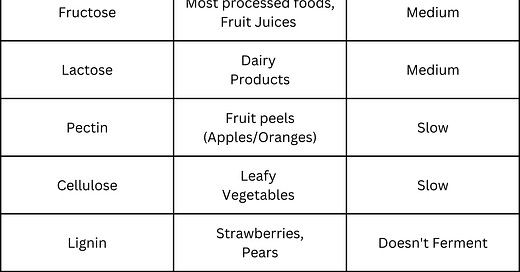5 ways to feel less bloated WITHOUT making changes to your diet
Simple. Effective. Sustainable.
In my last post, I covered why some foods create a lot of gas for some people.
The one line summary: they contain nutrients that your gut bacteria ferment to create gas.
Nutrients which ferment very fast become gas very fast. So if you struggle with bloating problems, it’s best to avoid them or control your portions.
Here’s the list for your reference:
Luckily, there are 5 techniques that can help you reduce the amount of these fermentable nutrients to help you make your food LESS gassy.
Transform your food from difficult → easy to digest
#1 Sprout
To reduce stachyose, raffinose and verbascos.
You can sprout beans, pulses and whole grains.
If you haven’t sprouted before, here’s the 101 👇
How much difference does it make?
Take a look.
Soaking and sprouting can almost entirely transform your food from difficult to easy to digest.
This law applies to all beans, pulses and whole grains, but varies in degree from ingredient to ingredient.
For example, 72 hour sprouting removes 100% of fermentable nutrients from chickpeas, but may only remove 50% from lima beans, for example.
#2 Heat, or lightly steam
To reduce resistant starch
If you have a very serious gas problem, opt for warm foods.
When it comes to salad, prefer lightly steamed over raw.
Heat does wonders to break bonds of complex molecules.
This makes it easier to digest.
This is particularly true for ingredients rich in starch like rice or potatoes.
If you cook rice, leave it in the fridge and eat it 1-2 hours later, it can contain nearly 300% MORE starch.
This means it can cause SERIOUS bloating and gas.
The right way to eat rice or potatoes for people who want to reduce gas: eat warm (or hot).
Here’s a list of starchy vegetables for your reference:
Corn, peas, sweet potatoes and beets are the ones to look out for.
#3 Process your dairy
To reduce lactose
If you want to drink milk without feeling bloated, here’s how to do it:
Find a good, trusted source of grass-fed A2 milk close-by.
Convert the milk into dahi (add a starter culture) into paneer (add some lemon) or into ghee (here’s the procedure).
Milk contains 10-14 grams of lactose per cup.
Dahi contains half the lactose that milk contains.
Paneers contains half the lactose that dahi contains.
Ghee is lactose-free.
So if you love your dairy, opt for dairy variants that are NOT liquid (no chaas, no raw milk).
See how much difference it makes to your bloating.
#4 Pickle
To reduce fructans
Achaar is more than taste. It’s incredibly digestible.
For onions, garlic and beets, pickling can reduce fermentable compounds by 80%!
If you are new to pickling, here’s the step-by-step:
How to pickle beets
How to pickle garlic
How to pickle onions
#5 Soak
All types of nuts
When you soak nuts, water-soluble nutrients leach into the water.
This includes several enzyme inhibitors which affect our digestion.
Ideally, you want to soak nuts in warm, salted water for best results.
Here are the different soaking times by type of nut.
Keep in mind that NONE of these is a substitute for portion control.
If you eat too much paneer, your body may not be able to digest all the protein.
If you eat too much pickle, your body may overheat.
If you eat too much warm rice, you still run the risk of elevated blood sugar.
Without potion control, NONE of these 5 recommendations will help you much.
Just something to keep in mind.
Next week, I’m going to help you read your stool and learn more about your digestion than your doctor will be able to tell you.
We’re going to talk about all things ew: sticky stool, yellow stool, floating stool…
If you liked this edition, please hit the❤️button and share this with at least one friend.
It will mean a lot to me.








Sir Myself DR.ASAD MBBS
wants to talk you for a case discussion regarding GUY ISSUE